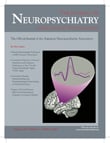SIR: Alcohol hallucinosis is a psychiatric condition characterized by auditory hallucinations, without consciousness disturbance, following drinking or cessation of alcohol. Although it is an important clinical issue in the management of alcohol dependence, the neuropsychiatric background of alcohol hallucinosis remains unknown. We report a case of alcohol hallucinosis in which we examined the neuropsychiatric background of the condition using N -isopropyl-p- 123 I iodoamphetamine ( 123 I-IMP) single photon emission computed tomography (SPECT).
Case Report
The patient was a 56-year-old Japanese junior high school graduate. He had a history of alcohol abuse of more than 30 years, with an average alcohol consumption of 200g/day (about 1.31 Japanese sake/day). He had experienced subacute auditory hallucinations and persecutional delusions for a month, during which time he intruded into his neighbor’s house and tried to set fire to the neighbor’s car. Finally, he was arrested by the police and admitted to our hospital.
On admission, he was alert, and physical and neurological examinations revealed no abnormalities except for a mild finger tremor. Laboratory tests demonstrated only mild elevation of liver enzymes and the result of a magnetic resonance imaging (MRI) scan was intact. However, 123 I-IMP SPECT revealed a decreased regional cerebral blood flow (rCBF) in the frontal lobe, left basal ganglia, and left thalamus. A regimen of diazepam, 40mg/day, and haloperidol, 6mg/day, was initiated, and the hallucinations and delusions almost disappeared within a month. At this point, diazepam was tapered off and haloperidol was tapered to 3mg/day. After the disappearance of the hallucinations, the rCBF in the basal ganglia and thalamus normalized, but the rCBF decrease in the frontal lobe remained.
In this case, rCBF decrease was observed in the frontal lobe, left basal ganglia, and left thalamus during the period of hallucinations, but the rCBF then normalized after recovery from the hallucinations, except in the frontal lobe.
Comment
Previous studies have demonstrated a toxic effect of alcohol on the frontal lobe, and hypofrontality is one of the characteristic findings of functional neuroimaging techniques in alcohol dependence.
1 On the other hand, functional abnormality of the frontal-subcortical circuit is well established in schizophrenia, the symptoms of which resemble alcohol hallucinosis. Sabri et al.
2 demonstrated a strong correlation between hallucinations and rCBF decrease in the cingulate, left thalamus, left frontal lobe, and left temporal lobe, and Soyka et al.
3,
4 showed frontal and thalamic dysfunction in a case of alcohol hallucinosis but did not report the functional changes following treatment, which we assessed in this study.
Collectively, the above findings suggest that the hypofrontality observed in this case probably reflects the effect of long-term alcohol dependence. Dysfunction of the left basal ganglia and left thalamus or coexistence of these abnormalities with frontal dysfunction could contribute to the development of alcohol hallucinosis, suggesting that alcohol hallucinosis may partially have a mutual neuropsychiatric background to that of schizophrenia.

